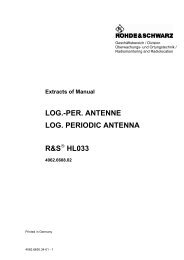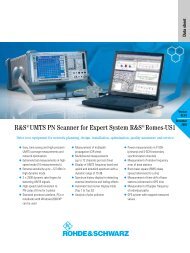Glossary of Video Terms and Acronyms - Isotest
Glossary of Video Terms and Acronyms - Isotest
Glossary of Video Terms and Acronyms - Isotest
You also want an ePaper? Increase the reach of your titles
YUMPU automatically turns print PDFs into web optimized ePapers that Google loves.
<strong>Video</strong> <strong>Terms</strong> <strong>and</strong> <strong>Acronyms</strong><br />
<strong>Glossary</strong><br />
<strong>of</strong> bits required for transmission <strong>and</strong> may be either lossless or lossy.<br />
b) Step-by-step procedure for the solution to a problem. First the problem<br />
is stated <strong>and</strong> then an algorithm is devised for its solution.<br />
Alias, Aliasing – Something other that what it appears to be. Stairsteps<br />
on what should be a smooth diagonal line are an example <strong>of</strong> spatial alias.<br />
Wagon wheels appearing to move backwards are an example <strong>of</strong> temporal<br />
alias. Aliases are caused by sampling <strong>and</strong> can be reduced or eliminated by<br />
pre-filtering, which can appear to be a blurring effect. Defects in the picture<br />
typically caused by insufficient sampling (violation <strong>of</strong> the Nyquist sampling<br />
rate) in the analog-to-digital conversion process or poor filtering <strong>of</strong><br />
digital video. Defects are typically seen as jaggies on diagonal lines <strong>and</strong><br />
twinkling or brightening in picture detail. Examples are: Temporal Aliasing –<br />
such as rotating wagon wheel spokes appearing to rotate in the reverse<br />
direction. Raster Scan Aliasing – such as sparkling or pulsing effects in<br />
sharp horizontal lines. Stair-Stepping – stepped or jagged edges in diagonal<br />
lines or the diagonal parts <strong>of</strong> a letter.<br />
Alignment – Most commonly, Head Alignment, but also used to describe<br />
the process <strong>of</strong> adjusting a recorder’s Bias <strong>and</strong> Equalization for optimum<br />
results from a specific tape.<br />
Alpha – See Alpha Channel <strong>and</strong> Alpha Mix.<br />
Alpha Channel – The alpha channel is used to specify an alpha value for<br />
each color pixel. The alpha value is used to control the blending, on a<br />
pixel-by-pixel basis, <strong>of</strong> two images. Alpha typically has a normalized value<br />
<strong>of</strong> 0 to 1. In a computer environment, the alpha values can be stored in<br />
additional bit planes <strong>of</strong> frame-buffer memory. When you hear about 32-bit<br />
frame buffers, what this really means is that there are 24 bits <strong>of</strong> color, 8<br />
each for red, green, <strong>and</strong> blue, along with an 8-bit alpha channel. Also see<br />
Alpha Mix.<br />
new pixel = (alpha) (pixel A color) + 1 – alpha (pixel B color)<br />
Alpha Mix – A way <strong>of</strong> combining two images. How the mixing is performed<br />
is provided by the alpha channel. The little box that appears over<br />
the left-h<strong>and</strong> shoulder <strong>of</strong> a news anchor is put there by an alpha mixer.<br />
Wherever the pixels <strong>of</strong> the little box appear in the frame buffer, an alpha<br />
number <strong>of</strong> “1” is put in the alpha channel. Wherever they don’t appear, an<br />
alpha number <strong>of</strong> “0” is placed. When the alpha mixer sees a “1” coming<br />
from the alpha channel, it displays the little box. Whenever it sees a “0,” it<br />
displays the news anchor. Of course, it doesn’t matter if a “1” or a “0” is<br />
used, but you get the point.<br />
Alphanumeric – Set <strong>of</strong> all alphabetic <strong>and</strong> numeric characters.<br />
ALU – See Arithmetic <strong>and</strong> Logic Unit.<br />
AM – A form <strong>of</strong> modulation where the level <strong>of</strong> the baseb<strong>and</strong> information<br />
affects the level <strong>of</strong> the carrier. See Amplitude Modulation.<br />
A-MAC – A MAC (Multiplexed Analog Component) with audio <strong>and</strong> data frequency<br />
multiplexed before modulation. See also MAC.<br />
Ambient Lighting – Light that emanates from no particular source, coming<br />
from all directions with equal intensity.<br />
Ambient Sound – A representative sample <strong>of</strong> background audio (such as<br />
a refrigerator hum or crowd murmur) particular to a shooting location.<br />
Ambient sound is gathered in the course <strong>of</strong> a production to aid the sound<br />
8 www.tektronix.com/video_audio<br />
editor in making cuts or filling in spaces between dialog. Also called Room<br />
Tone.<br />
American Television <strong>and</strong> Communications – See ATC.<br />
A-Mode Edit – An editing method where the footage is assembled in the<br />
final scene order. Scene 1, scene 2, etc.<br />
Amplitude – The height <strong>of</strong> a waveform above or below the zero line.<br />
Amplitude Modulation – a) The process used for some radio (AM broadcast,<br />
in North American audio service broadcast over 535 kHz-1705 kHz)<br />
<strong>and</strong> television video transmission. A low-frequency (program) signal modulates<br />
(changes) the amplitude <strong>of</strong> a high-frequency RF carrier signal (causing<br />
it to deviate from its nominal base amplitude). The original program<br />
signal is recovered (demodulated) at the receiver. This system is extensively<br />
used in broadcast radio transmission because it is less prone to signal<br />
interference <strong>and</strong> retains most <strong>of</strong> the original signal quality. In video, FM is<br />
used in order to record high quality signals on videotape. b) The process<br />
by which the amplitude <strong>of</strong> a high-frequency carrier is varied in proportion<br />
to the signal <strong>of</strong> interest. In the PAL television system, AM is used to encode<br />
the color information <strong>and</strong> to transmit the picture. Several different forms <strong>of</strong><br />
AM are differentiated by various methods <strong>of</strong> sideb<strong>and</strong> filtering <strong>and</strong> carrier<br />
suppression. Double sideb<strong>and</strong> suppressed carrier is used to encode the<br />
PAL color information, while the signal is transmitted with a large-carrier<br />
vestigial sideb<strong>and</strong> scheme.<br />
Amplitude Non-Uniformity – A term used in connection with magnetic<br />
tape testing <strong>and</strong> refers to the reproduced peak-to-peak voltage <strong>and</strong> its<br />
variation from what was recorded.<br />
Amplitude Versus Frequency Response – Refer to the Frequency<br />
Response discussion.<br />
AM-VSB (Amplitude Modulation with Vestigial Sideb<strong>and</strong>) – The form<br />
<strong>of</strong> modulation used in broadcast <strong>and</strong> cable television transmission. It is<br />
more efficient than dual-sideb<strong>and</strong> amplitude modulation <strong>and</strong> is easier to<br />
implement than single-sideb<strong>and</strong> amplitude modulation.<br />
Analog – a) A continuous electrical signal that carries information in the<br />
form <strong>of</strong> variable physical values, such as amplitude or frequency modulation.<br />
b) A signal which moves through a continuous range <strong>of</strong> settings or<br />
levels. c) An adjective describing any signal that varies continuously as<br />
opposed to a digital signal that contains discrete levels representing the<br />
binary digits 0 <strong>and</strong> 1. d) A signal that is an analogy <strong>of</strong> a physical process<br />
<strong>and</strong> is continuously variable, rather than discrete. See also Digitization.<br />
Analog Components – <strong>Video</strong> signals in which a continuously variable<br />
voltage or current (rather than a set <strong>of</strong> digital numbers) represents a pixel.<br />
Analog Interface – An interface between a display controller <strong>and</strong> a display<br />
in which pixel colors are determined by the voltage levels on three<br />
output lines (RGB). Theoretically, an unlimited number <strong>of</strong> colors can be supported<br />
by this method (24 bits per pixel allows 16,777,216 colors). The<br />
voltage level on any line varies between zero volts (for black) to about 700<br />
millivolts (for maximum brightness).<br />
Analog Monitor – A video monitor which accepts analog signals. Several<br />
types <strong>of</strong> inputs are accepted by analog monitors: composite video, RGB &<br />
sync, Y/C, YUV <strong>and</strong> any combination <strong>of</strong> these formats. The signals transmit-





